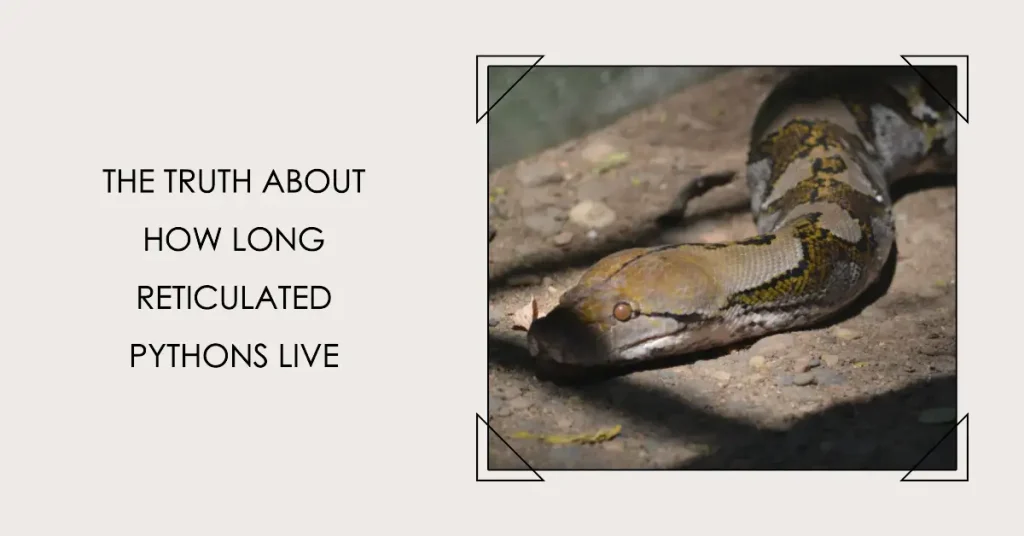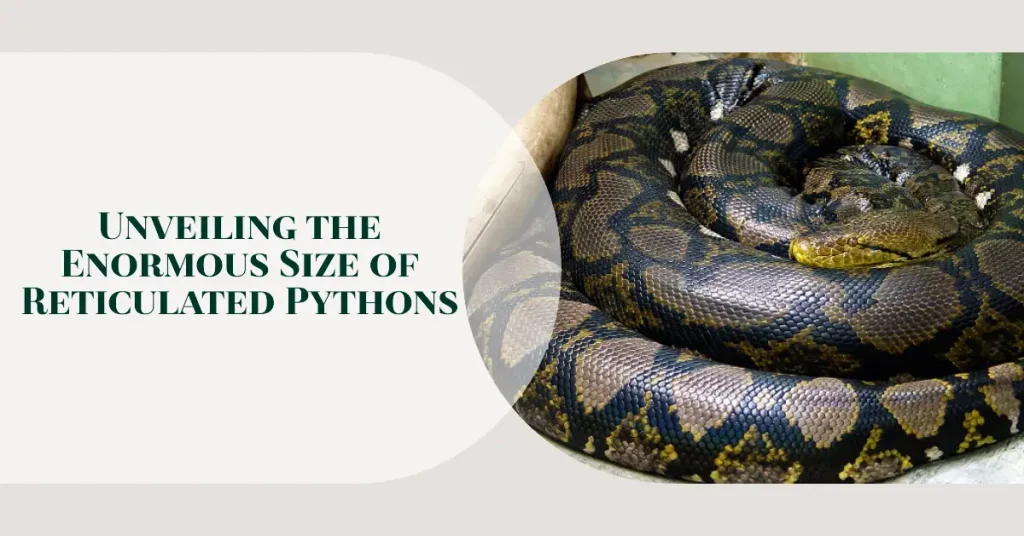I have always been fascinated by the impressive longevity of reticulated pythons. These beautiful snakes are known for their incredible size, beauty, and strength, but their lifespan is equally remarkable.
In this article, we will delve into the mystery of reticulated python lifespan and explore the various factors that contribute to their impressive longevity. From their natural habitat in the wild to their life in captivity, we will examine the essential components that help these snakes live long and healthy lives.
Key Takeaways:
- The reticulated python is known for its impressive lifespan
- Factors such as habitat, diet, and care contribute to their longevity
- Extended lifespans are possible in captivity with proper care and husbandry practices
How Long Do Reticulated Pythons Live?
When it comes to the lifespan of reticulated pythons, there is no definitive answer. While these snakes are known for their impressive longevity, their lifespan can vary depending on several factors.
Generally, the average lifespan of a reticulated python in the wild is around 20-25 years. However, in captivity, they can live up to 30 years or more in some cases. Factors such as diet, habitat, and medical care can all play a role in determining their lifespan.
Factors Affecting Reticulated Python Lifespan
There are many factors that can affect the lifespan of reticulated pythons. In the wild, habitat loss and hunting can significantly impact their longevity. Additionally, injuries and diseases can shorten their lifespan as well.
In captivity, however, reticulated pythons can enjoy an extended lifespan with proper care and husbandry practices. Feeding them a healthy diet, providing adequate space, and ensuring proper medical care are all critical factors in promoting their longevity.
In summary, while the average lifespan of a reticulated python may be around 20-25 years in the wild, captivity offers the potential for them to live much longer with proper care and attention. As with all living creatures, providing a suitable environment and attentive care can contribute to a long and healthy life for these impressive snakes.
Factors Affecting Reticulated Python Lifespan
Several factors can influence the lifespan of reticulated pythons, both in the wild and in captivity. In this section, we will examine some of the most common factors contributing to their longevity and explore how they impact their lifespan.
| Factor | Description |
|---|---|
| Diet | A reticulated python’s diet plays a crucial role in its overall health and lifespan. In the wild, they feed on a variety of prey, including rodents, birds, and other small mammals. In captivity, a well-balanced diet can significantly extend their lifespan, while inadequate nutrition may shorten it. |
| Environmental conditions | The environmental conditions that reticulated pythons are exposed to can also affect their lifespan. In the wild, they thrive in tropical forests and grasslands, while in captivity, it is essential to provide them with the right temperature, humidity, and lighting conditions that mimic their natural environment. |
| Genetics | The genetics of a reticulated python can also play a significant role in its lifespan. Some individuals may be more genetically predisposed to live longer, healthier lives than others. However, it is currently unclear whether there is a genetic basis for their longevity. |
| Healthcare and veterinary attention | Another critical factor that can contribute to the lifespan of reticulated pythons is the level of healthcare and veterinary attention they receive. Regular check-ups, preventative care, and prompt treatment of illnesses can all enhance their health and longevity. |
By understanding these factors and taking appropriate measures, we can help promote the longevity of reticulated pythons in both the wild and captivity.
Longevity in the Wild
Reticulated pythons are known to have an impressive lifespan in the wild, with some individuals reaching ages of up to 25 years old. However, the average lifespan of a reticulated python in the wild is typically between 15 and 20 years.
The lifespan of a reticulated python in the wild can be influenced by various factors that may affect their health and survival. These factors include the availability of prey, competition with other predators, and exposure to diseases or environmental hazards.
Despite these challenges, reticulated pythons have evolved to adapt to their natural environment, allowing them to live a long and healthy life in the wild.
Extended Lifespan in Captivity
When kept in captivity, reticulated pythons have the potential to live much longer than their wild counterparts. In fact, some individuals have been known to live well into their 30s or even 40s.
Factors contributing to longevity in captivity
The extended lifespan of captive reticulated pythons can be attributed to several factors:
| Factor | Description |
|---|---|
| Proper nutrition | A well-balanced diet that meets the nutritional needs of the python is crucial for promoting longevity. |
| High-quality veterinary care | Regular check-ups and prompt treatment of any health issues are vital for ensuring a long and healthy life. |
| Optimal habitat conditions | Captive reticulated pythons require an environment that closely mimics their natural habitat, with appropriate temperature, humidity, and substrate. |
Additionally, reticulated pythons in captivity are not subjected to the same stresses and dangers as their wild counterparts, such as predation, food scarcity, and habitat destruction.
Record-breaking cases
Some of the longest-lived reticulated pythons on record have reached remarkable ages:
- The oldest reticulated python in captivity was a female named Medusa, who lived to be 47 years old before passing away in 2021.
- Another female reticulated python, named Fluffy, lived to be an astounding 49 years old before her death in 2010.
While these cases are exceptional, they demonstrate the potential for reticulated pythons to live long and healthy lives in captivity with proper care and husbandry.
Care and Husbandry for Longevity
Aside from genetics and natural factors, the care and husbandry of reticulated pythons play a crucial role in promoting their longevity in captivity. I have seen firsthand the impact of proper care and husbandry on the lifespan of these fascinating creatures.
The following are some essential tips to consider when caring for reticulated pythons:
- Ensure proper nutrition: Reticulated pythons require a diet rich in high-quality protein. It is recommended to feed them appropriately sized prey every two to four weeks, depending on their age and size. However, overfeeding can lead to obesity, which can have adverse effects on their health.
- Provide adequate housing: Reticulated pythons need ample space to move around comfortably. A spacious enclosure with adequate temperature and humidity levels is essential for their well-being. Additionally, providing hiding spots and climbing structures can help promote their natural behaviors and reduce stress.
- Maintain proper hygiene: Keeping the enclosure clean and free from pathogens is essential to prevent illness and disease. Regular cleaning and disinfection of the enclosure and accessories are required to maintain a healthy environment for the snake.
- Monitor health regularly: Regular health checks by a veterinarian with experience in treating reptiles can aid in early detection of any health issues. Signs of distress, such as lethargy, loss of appetite, or abnormal behavior, should be addressed immediately to prevent complications.
Following these guidelines can help ensure that reticulated pythons receive the proper care and husbandry necessary for a long and healthy life. As with any animal, it is essential to do thorough research and consult with experts before adopting a reticulated python as a pet.
Record-Breaking Lifespans of Reticulated Pythons
While the average lifespan of reticulated pythons is impressive, some individuals have managed to live well beyond the norm. The longest-lived reticulated python on record is a female named Medusa, who lived for an incredible 28 years in captivity before passing away in October 2011.
In addition to Medusa, there are several other cases of reticulated pythons with record-breaking lifespans. One such individual is a male named Fluffy, who lived to be 27 years old before passing away in 2010. Another notable example is a female named Samantha, who lived for 26 years in captivity.
While these cases are remarkable, it is worth noting that they are not the norm. Most reticulated pythons will live for around 20-25 years in captivity and less in the wild. However, the factors that may have contributed to the extended lifespan of these record-breaking individuals can offer insights into the care and husbandry practices that can promote longevity in captive reticulated pythons.
Comparing Lifespans of Reticulated Pythons with Other Python Species
When it comes to snake lifespans, some species outlive others. Reticulated pythons are known for their impressive longevity, but how do they compare to other python species?
The average lifespan of reticulated pythons is between 15 and 25 years in the wild, with some individuals living up to 30 years or more. In comparison, ball pythons have a shorter lifespan of 20 to 30 years, while Burmese pythons can live up to 25 years.
However, there are some python species that outlive even the reticulated python. The African rock python, for instance, can live up to 30 years in the wild, while the green anaconda can reach ages of over 30 years in captivity.
Factors such as diet, habitat, and environmental conditions can influence the lifespan of different python species. For example, a captive python fed a nutritious and balanced diet in a properly maintained habitat may live longer than a wild python facing threats such as predation, disease, and habitat loss.
It is important to note that these are average lifespans and some individuals may live much longer or shorter than the norm. Genetics, individual health, and care also play a crucial role in determining a python’s lifespan.
While reticulated pythons are known for their impressive longevity, there are other python species that can outlive them. Factors such as diet, habitat, and individual care also play a significant role in determining the lifespan of different python species.
Conclusion
After exploring the lifespan of reticulated pythons, it is clear that they are one of the longest-lived snake species in the world. Their impressive longevity can be attributed to various factors, including genetics, habitat conditions, nutrition, and proper care in captivity.
On average, reticulated pythons live between 20 and 30 years in the wild, but they can reach up to 30 to 40 years in captivity with proper care and husbandry. In some extraordinary cases, they have been known to live up to 50 years or even longer.
Factors Affecting Longevity
The factors that contribute to the lifespan of reticulated pythons are complex and multifaceted. In the wild, their longevity can be influenced by various factors such as habitat loss, hunting, and climate change. In captivity, factors such as proper nutrition, habitat size, and veterinary care can significantly impact their lifespan.
Care and Husbandry Practices
To promote the longevity of reticulated pythons in captivity, it is crucial to provide them with a suitable habitat, proper nutrition, and regular veterinary care. Additionally, handlers should avoid overhandling, provide environmental enrichment, and maintain proper handling techniques to ensure the snake’s physical and emotional well-being.
Comparing Lifespans with Other Python Species
When compared to other python species, the reticulated python’s lifespan is relatively long. However, it is essential to note that the lifespan of snakes can vary significantly based on species, habitat, and other factors. For instance, the ball python has a maximum lifespan of around 30 years, while the Burmese python can live up to 25 years in captivity.
In conclusion, the lifespan of reticulated pythons is an impressive feat of nature. By understanding the factors that influence their longevity and providing proper care and husbandry, snake handlers can help ensure these magnificent animals live healthy, long lives.
FAQ
Q: How long do reticulated pythons live?
A: Reticulated pythons have an average lifespan of around 20-25 years in the wild, but can live up to 30 or even 40 years in captivity with proper care.
Q: What factors affect reticulated python lifespan?
A: Various factors can influence the lifespan of reticulated pythons, including genetics, diet, habitat, temperature, and overall health.
Q: What is the lifespan of reticulated pythons in the wild?
A: Reticulated pythons in the wild can live for about 20-25 years on average, although some individuals may reach an age of up to 30 years.
Q: How long can reticulated pythons live in captivity?
A: Reticulated pythons can live much longer in captivity, with some individuals reaching ages of 30 or even 40 years when provided with proper care, nutrition, and suitable living conditions.
Q: What care and husbandry practices are important for promoting reticulated python longevity?
A: To promote the longevity of reticulated pythons in captivity, essential care and husbandry practices include providing a suitable enclosure with proper temperature and humidity levels, a varied and nutritious diet, regular veterinary check-ups, and maintaining a clean and stress-free environment.
Q: Are there any record-breaking cases of reticulated pythons with exceptionally long lifespans?
A: Yes, there have been remarkable cases of reticulated pythons living beyond the average lifespan, with some individuals reaching ages of 40 or even 50 years. Factors like optimal care, genetics, and favorable living conditions may have contributed to their longevity.
Q: How does the lifespan of reticulated pythons compare to other python species?
A: Reticulated pythons generally have a longer lifespan compared to many other python species, such as the ball python or the Burmese python. However, the specific lifespan can vary depending on the species and individual care provided.
Featured image: Kailash kumbhkar, CC BY-SA 4.0, via Wikimedia Commons


